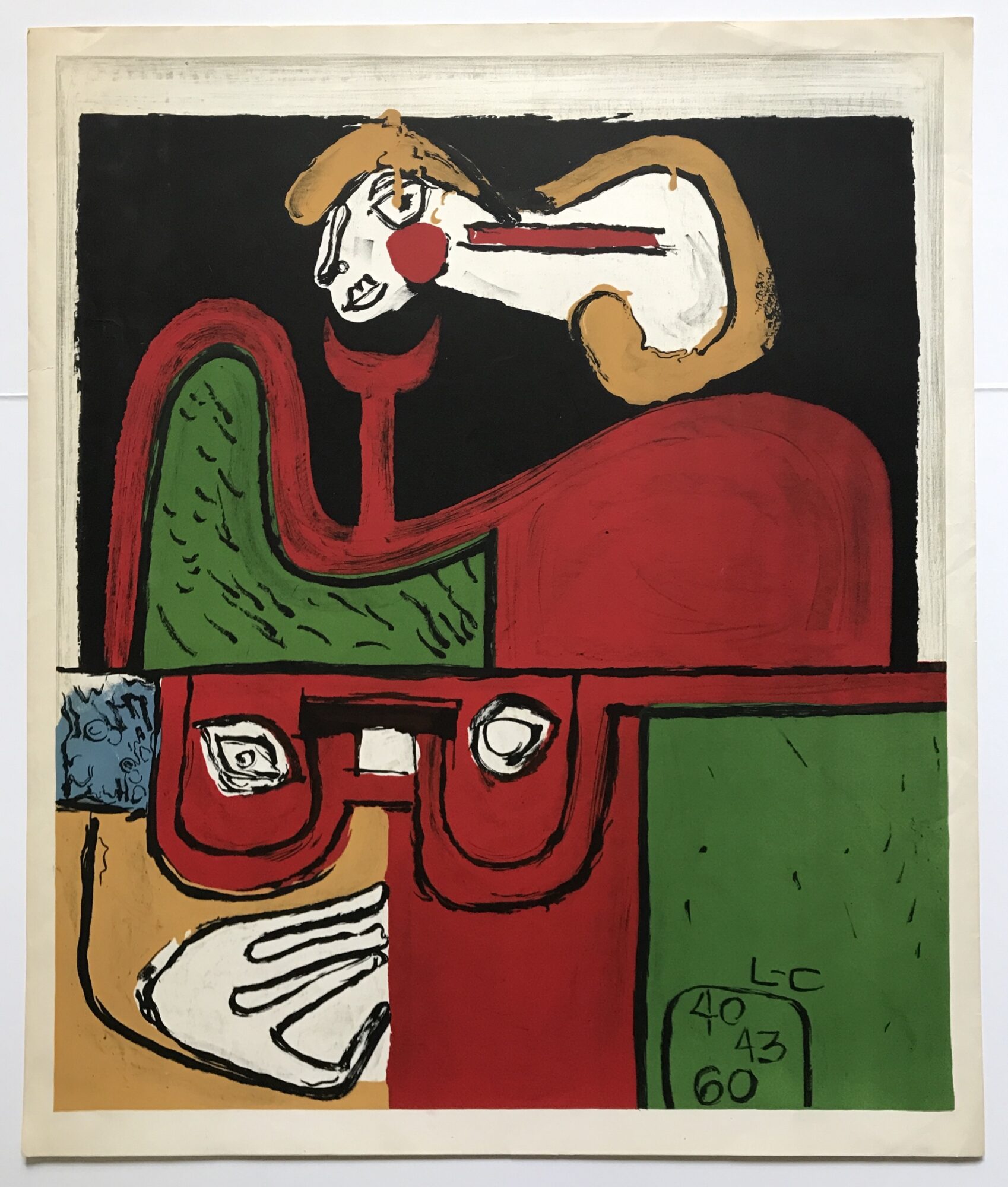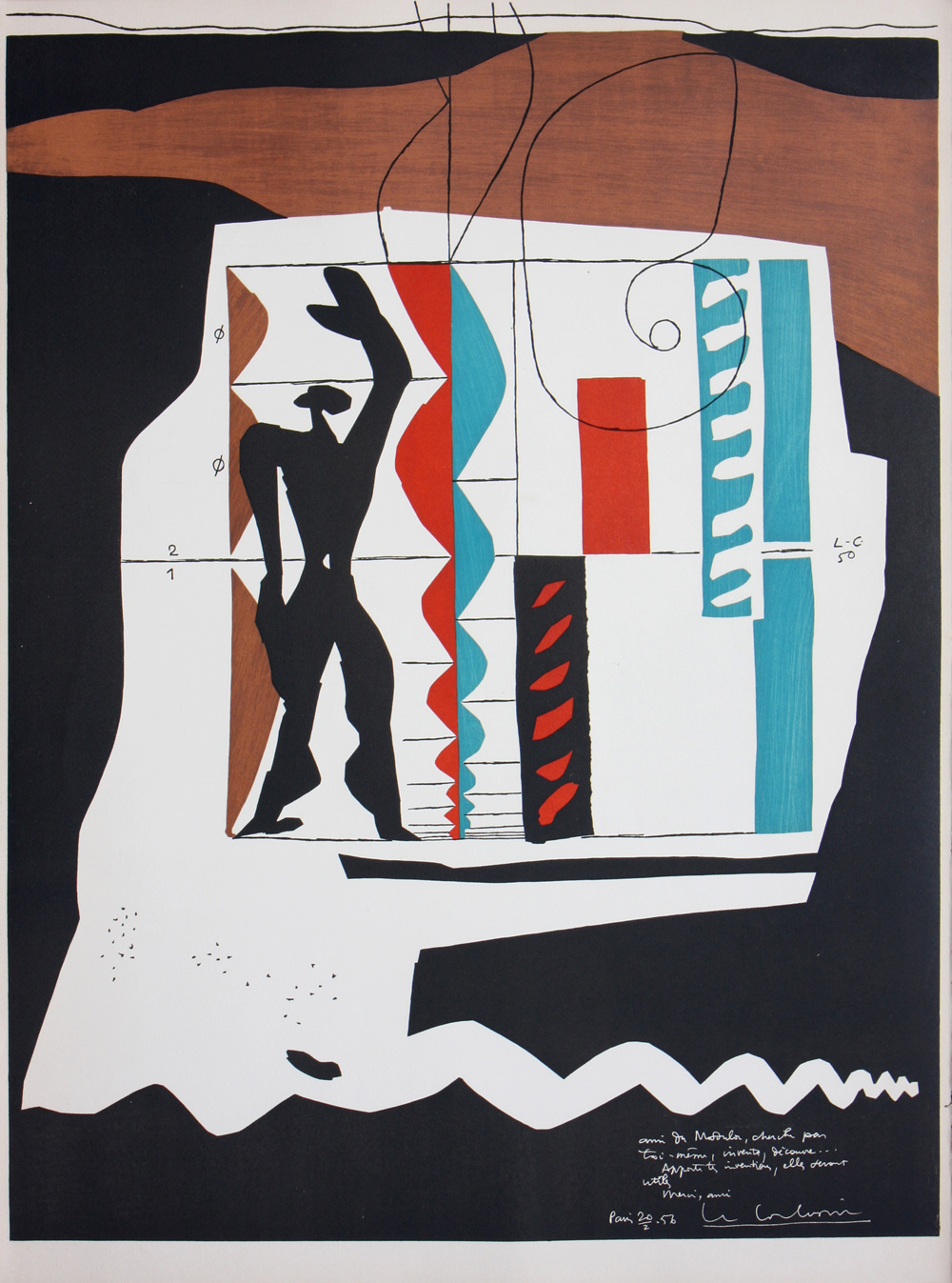Le Corbusier – Portrait
Le Corbusier, Portrait 1960 is a limited edition Le Corbusier Lithograph in colors. Le Corbusier, Portrait is signed and dated in the plate. Printed by Mourlot, Paris. Weber Pg 68.
At the beginning of the 1930s, the feminine figure took a dominating place in Le Corbusier’s art, and would continue to be a central theme for Le Corbusier’s original prints, lithographs, etchings, collages, paintings, and sculptures. Although Le Corbusier was primarily international recognized for his developments in modern architecture and furniture, Le Corbusier did have a number of smaller exhibitions of his art, mostly toward that later end of his life time. Le Corbusier’s art emphasized clear forms and structures, corresponding to his architecture, which is based on elemental geometric forms. In 1943 Le Corbusier applied a similar interdisciplinary approach to developing “Modulor”, a system of proportion based on the male figure and the Golden Ratio, used to determine the proportions of units in architecture and technology. It is also the basis of Le Corbusier’s work in furniture design. Many of Le Corbusier’s pieces of furniture have become design classics. Le Corbusier placed systems of harmony and proportion at the centre of his design philosophy.
| Title | Portrait |
|---|---|
| Year | 1960 |
| Medium | Lithograph |
| Edition | Limited Edition |
| Catalogue Raisonné | Weber Pg 68 |
| Signature | Plate Signed |
| Size | 29.75 x 25 (in) 76 x 64 (cm) |
| Price | Price on Request |
Description
Le Corbusier, Portrait 1960 is a limited edition Le Corbusier Lithograph in colors. Le Corbusier, Portrait is signed and dated in the plate. Printed by Mourlot, Paris. Weber Pg 68.
Artist Le Corbusier was born as Charles-Edouard Jeanneret on October 6, 1887 – August 27, 1965 in a small provincial town in Switzerland. Interested in visual art from a very early age Le Corbusier began to study at the Ecole d’Art in La Chaux-de-Fonds, Switzerland in 1900. There Le Corbusier trained as an engraver and goldsmith, but from 1904 also studied architecture.
Around 1907, Le Corbusier traveled to Paris, where Le Corbusier found work in the office of Auguste Perret, the French pioneer of reinforced concrete. In 1908 Le Corbusier studied architecture in Vienna with Josef Hoffmann, and in 1910 and 1911, Le Corbusier worked in Berlin for the renowned architect Peter Behrens.
Later that year Le Corbusier travelled to Greece and Turkey, filling sketchbooks with renderings of what he saw, including many famous sketches of the Parthenon, whose forms Le Corbusier would later praise in his work Vers une architecture (1923).
During World War I Le Corbusier taught at his old school in La-Chaux-de-Fonds, not returning to Paris until the war was over. During these four years in Switzerland, Le Corbusier worked on theoretical architectural studies using modern techniques that would become the foundation for most of Le Corbusier’s architecture, art, sculpture and graphic works for the next ten years.
After moving back to Paris in 1918, Le Corbusier befriended Cubist artists, Fernand Leger and Amedee Ozenfant. Ozenfant encouraged Le Corbusier to paint, and the two began a period of collaboration. Le Corbusier and Ozenfant rejected Cubism as irrational and “romantic,” and together jointly published their manifesto Apres le cubism, establishing a new artistic movement: Purism. Le Corbusier’s art from the Purist period could be characterized as “patient research,” were Le Corbusier untiringly searched for valid form. Le Corbusier created many Still Life themed paintings and artworks during this period.
Le Corbusier, Portrait
Le Corbusier prints for sale
Le Corbusier art for sale
Additional information
| Title | Portrait |
|---|---|
| Year | 1960 |
| Medium | Lithograph |
| Edition | Limited Edition |
| Catalogue Raisonné | Weber Pg 68 |
| Signature | Plate Signed |
| Size | 29.75 x 25 (in) 76 x 64 (cm) |
| Price | Price on Request |





